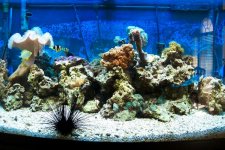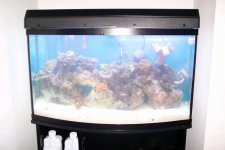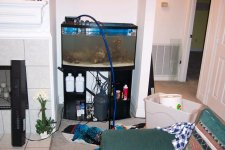You are using an out of date browser. It may not display this or other websites correctly.
You should upgrade or use an alternative browser.
You should upgrade or use an alternative browser.
Can I add sand to a running tank?
- Thread starter RaceFaceR1
- Start date
Sorry... It's a 30 gallon... I have aproximitly 25 to 30lbs of LR...
And I'm not sure on how much sand I want to add... I just want some in a lille corner... A few lbs mabe? Maybe you can suggest on how many pounds I can add?
And what type of sand should I add? LS ?!?!
And I'm not sure on how much sand I want to add... I just want some in a lille corner... A few lbs mabe? Maybe you can suggest on how many pounds I can add?
And what type of sand should I add? LS ?!?!
Yes, you can add sand to an existing tank, just do it slowly. Don' use "sand" sand, use "aragonite" sand. The major brand is Caribsea, but there are others. It's available in various sizes (from oolitic, e.g. very fine, to 1-4mm mixed). The 1-4mm mixed has some of the looks of crushed coral (which I like); the 1-2mm size (Reef Floor grade, I think) is also fine. This is "dead" sand, as opposed to "live."
I would personally remove existing crushed coral substrate, because the particles are largish, and trap leftover food, making it difficult for bristleworms and other worms to live in the sand. The smaller grades are small enough to establish a pretty lively community of baby stars, bristleworms, peanut worms, cerith snails, pods, etc. (should you be fortunate enough to have them).
As ufans pointed out, "SLOWLY" is the watchword. When you add sand (by that, I mean aragonite) to an existing tank, you will generally create a dust storm in your tank. Pouring thru a PVC funnel, or other similar contraption, minimizes the dust storm.
Live sand in a bag, as far as I'm concerned, is $ in a hole. The only benefit it's got is bacterial cultures. I'm not (any longer) a biologist, but how can worms, snails, minicrustaceans, etc. possibly remain alive in a sealed polybag sitting on a store shelf with no expiration date??? If you want live sand, much better to borrow (beg, buy, steal) a couple of cups from a friendly neighborhood reefer (or nice LFS) to seed dry aragonite that you rinse. Or, buy real live sand, collected from the sea floor, by one of the aquaculture companies (e.g. Tampa Bay Saltwater). Collected live sand shipped from the Ocean is the best live sand. It's not pristine white, but then, your substrate won't be pristine white after a month . But collected live sand is full of mini-life (mini stars, mini chitons, mini other mollusks, mini worms, mini crustaceans) that do a great job as detritivores.
. But collected live sand is full of mini-life (mini stars, mini chitons, mini other mollusks, mini worms, mini crustaceans) that do a great job as detritivores.
How much do you need? Do either a search for DSB, or make a post asking about DSB's Seriously, IMO, either go shallow (about 1/2") for looks, or go way deep (4-6") for nitrate reduction, but don't be Mr. In Between.
Seriously, IMO, either go shallow (about 1/2") for looks, or go way deep (4-6") for nitrate reduction, but don't be Mr. In Between.
I'm sorry, I don't recall the cubic inches to lbs of substrate conversion.
HTH,
Hy
I would personally remove existing crushed coral substrate, because the particles are largish, and trap leftover food, making it difficult for bristleworms and other worms to live in the sand. The smaller grades are small enough to establish a pretty lively community of baby stars, bristleworms, peanut worms, cerith snails, pods, etc. (should you be fortunate enough to have them).
As ufans pointed out, "SLOWLY" is the watchword. When you add sand (by that, I mean aragonite) to an existing tank, you will generally create a dust storm in your tank. Pouring thru a PVC funnel, or other similar contraption, minimizes the dust storm.
Live sand in a bag, as far as I'm concerned, is $ in a hole. The only benefit it's got is bacterial cultures. I'm not (any longer) a biologist, but how can worms, snails, minicrustaceans, etc. possibly remain alive in a sealed polybag sitting on a store shelf with no expiration date??? If you want live sand, much better to borrow (beg, buy, steal) a couple of cups from a friendly neighborhood reefer (or nice LFS) to seed dry aragonite that you rinse. Or, buy real live sand, collected from the sea floor, by one of the aquaculture companies (e.g. Tampa Bay Saltwater). Collected live sand shipped from the Ocean is the best live sand. It's not pristine white, but then, your substrate won't be pristine white after a month
How much do you need? Do either a search for DSB, or make a post asking about DSB's
I'm sorry, I don't recall the cubic inches to lbs of substrate conversion.
HTH,
Hy
Yes you can. I gather this is about your problem with the goby, though I'd suggest removing all of your crushed coral substrate.
If you have a spare tank or have access to a large plastic tub, buy a 40# bag of suger size aragonite and put it in this container with new saltwater, heater and a powerhead for circulation. Now take a piece of raw shrimp, put it in a small piece of nylon stocking with a string attached and place it in the sand with the string sticking out of the sand. Wait about 3 weeks and pull out the remains of the piece of shrimp. You'll now have a sand bed with the correct bacteria ready to go.
Now you'll have to remove your old crushed coral substrate, live rock and inhabitants and about 85 to 90% of the water. Have at least an 90% water change ready. After the old substrate is removed put your new live sand in the tank, add new saltwater and your live rock but you'll have to wait for a few hours for your tank to clear before you put your inhabitants back in. You will have no recycle this way.
btw If you want, leave a sprinkling of your crushed coral on top of your new sand as your goby will use these larger piece to construct its lair.
Regards,
David Mohr
If you have a spare tank or have access to a large plastic tub, buy a 40# bag of suger size aragonite and put it in this container with new saltwater, heater and a powerhead for circulation. Now take a piece of raw shrimp, put it in a small piece of nylon stocking with a string attached and place it in the sand with the string sticking out of the sand. Wait about 3 weeks and pull out the remains of the piece of shrimp. You'll now have a sand bed with the correct bacteria ready to go.
Now you'll have to remove your old crushed coral substrate, live rock and inhabitants and about 85 to 90% of the water. Have at least an 90% water change ready. After the old substrate is removed put your new live sand in the tank, add new saltwater and your live rock but you'll have to wait for a few hours for your tank to clear before you put your inhabitants back in. You will have no recycle this way.
btw If you want, leave a sprinkling of your crushed coral on top of your new sand as your goby will use these larger piece to construct its lair.
Regards,
David Mohr
davidmohr":25i6civ9 said:Yes you can. I gather this is about your problem with the goby, though I'd suggest removing all of your crushed coral substrate.
If you have a spare tank or have access to a large plastic tub, buy a 40# bag of suger size aragonite and put it in this container with new saltwater, heater and a powerhead for circulation. Now take a piece of raw shrimp, put it in a small piece of nylon stocking with a string attached and place it in the sand with the string sticking out of the sand. Wait about 3 weeks and pull out the remains of the piece of shrimp. You'll now have a sand bed with the correct bacteria ready to go.
Now you'll have to remove your old crushed coral substrate, live rock and inhabitants and about 85 to 90% of the water. Have at least an 90% water change ready. After the old substrate is removed put your new live sand in the tank, add new saltwater and your live rock but you'll have to wait for a few hours for your tank to clear before you put your inhabitants back in. You will have no recycle this way.
btw If you want, leave a sprinkling of your crushed coral on top of your new sand as your goby will use these larger piece to construct its lair.
Regards,
David Mohr
Your right on the money!
The tank was up and running with CC for over 2 years before I got tired of having to "vacuum" the CC. Then I finally just got a 12 pack and made a day of cleaning the tank and replacing the CC with LS. I really like the way it looks now better than before.
Well I'm going to buy sand tonight... And figure out how I'm goging to do this... I will probobly do little section of the tank at a time.....
Now I have to make sure I don't take out hermit crabs when I take the CC out...
I'll take pics and post my "CC to sand" adventure...
Now I have to make sure I don't take out hermit crabs when I take the CC out...
I'll take pics and post my "CC to sand" adventure...
DLART89":19s2zisw said:Yeah, just remember - Dont start drinking until after the work starts or you will never get done! :wink:
LOL... I came home with the aragonite after work yesterday... Of course my girlfriend was not happy
Oh well... I started to rince some of it... I'll work on it more tonight...
Tanks for all your advise BTW
Marc









